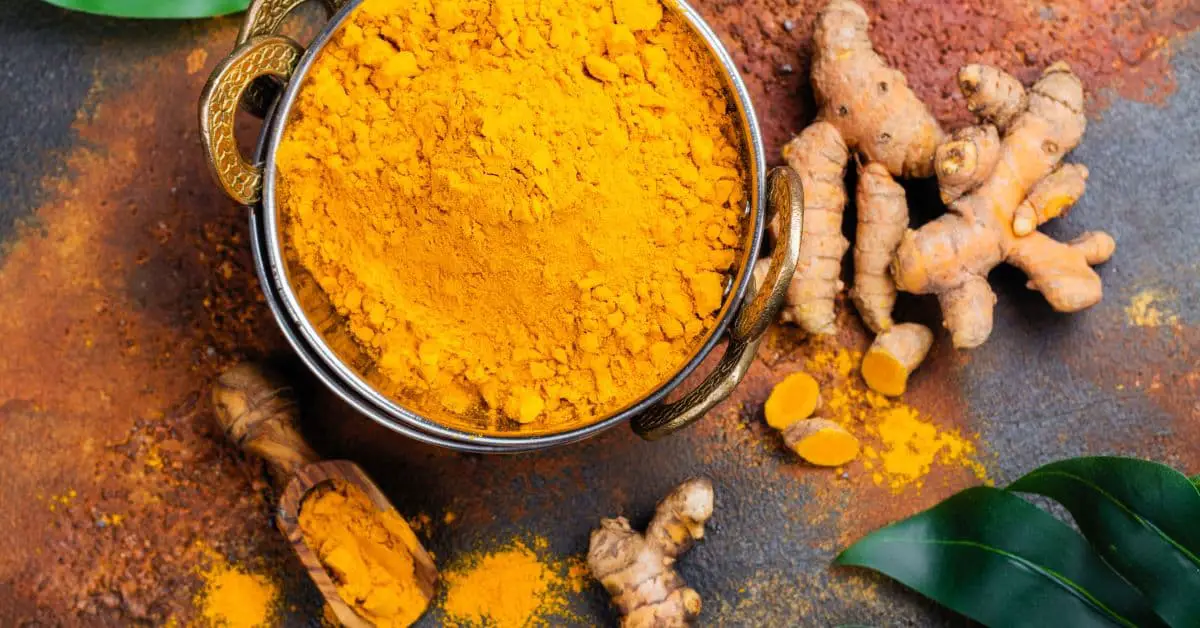How To Use Turmeric In Cooking: Flavorful Tips
Turmeric, a vibrant yellow spice, has been weaving its color and flavor into the tapestry of culinary traditions for centuries. Originating from the root of the Curcuma longa plant, it offers more than its warm, bitter taste; it boasts a storied history of both culinary and medicinal use, particularly in the practices of traditional medicine in India. As you explore the aisles of your local market, the golden hue of turmeric powder might catch your eye, carrying with it whispers of ancient health remedies and a promise to enhance your dishes with its distinctive flavor.
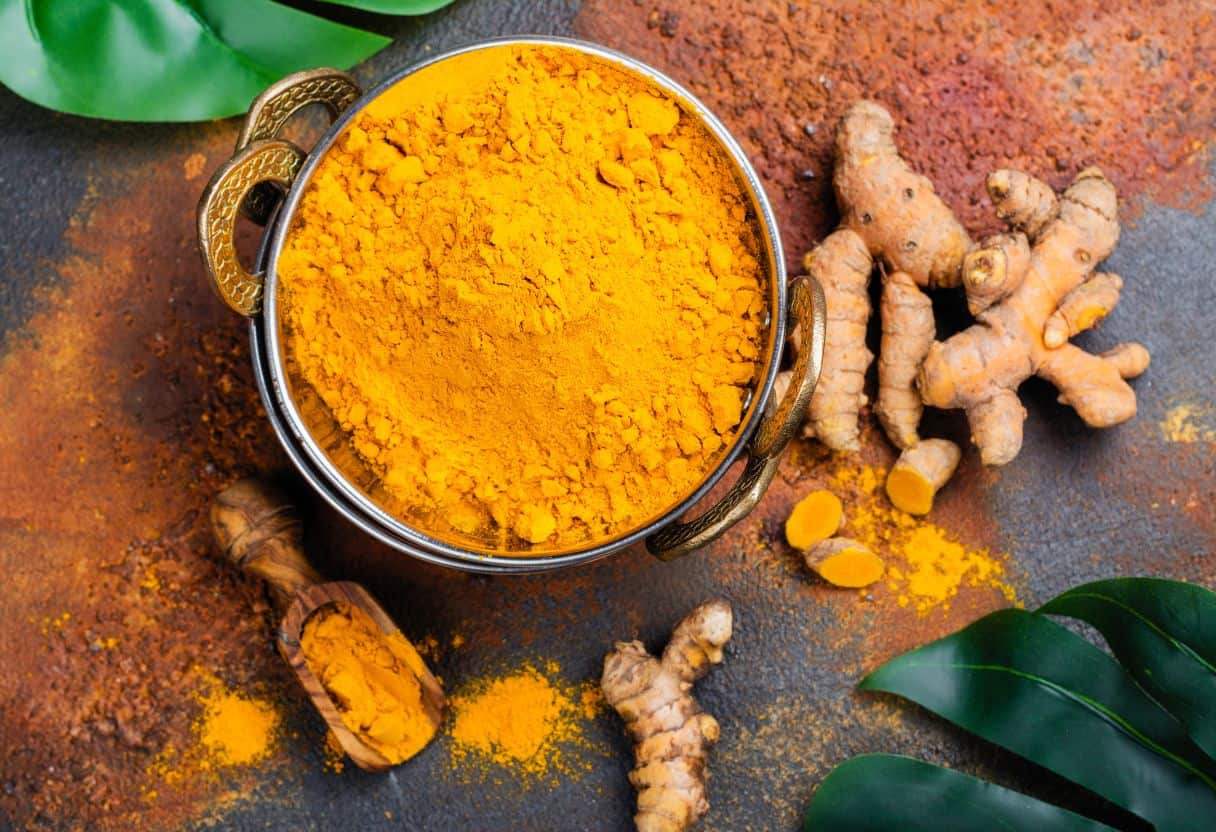
Integrating turmeric into your cooking routine can be as simple as adding a pinch of the ground spice to your soups and stews, or as adventurous as grating fresh turmeric for a vibrant stir-fry or smoothie. With its subtle earthiness and slight peppery note, turmeric pairs wonderfully with a myriad of ingredients, offering versatility in both savory and sweet recipes. If you’re looking to elevate the health factor on your plate, integrating turmeric is a wise choice, as its active compound, curcumin, is linked to numerous health benefits, including anti-inflammatory properties.
Key Takeaways
- Turmeric adds unique flavor and color to a variety of dishes from savory to sweet.
- Fresh and dried turmeric can be used in cooking, impacting both the dish’s taste and health value.
- Storing turmeric properly ensures its longevity, making it a staple spice in your pantry.
Historical Use and Health Benefits
As you explore the vibrant world of spices, turmeric holds a distinctive place in culinary and medicinal history. Its golden hue has not only colored the fabric of various cultures but also painted a picture of health across generations.
Origins and Cultural Significance
Originating from the fertile lands of Southeast Asia, turmeric has been a cornerstone in Indian cuisine and rituals for thousands of years. Evidence found near New Delhi suggests that turmeric was being used as early as 2500 BCE, and its presence became prominent around 500 BCE. Revered for its deep saffron-yellow color, this spice is integral to the identity and heritage of many Asian communities, often used in wedding ceremonies and religious rites to signify purity and prosperity.
Turmeric in Traditional Medicine
Turmeric was traditionally harnessed for its powerful anti-inflammatory and antioxidant properties, primarily due to the presence of curcumin. In Ayurvedic medicine, turmeric was prescribed to treat various ailments, ranging from pain relief to improving digestion. Modern research echoes this sentiment, investigating its potential in combating conditions like cancer. For instance, a study showed that curcumin exhibits the ability to target cancer cells while sparing healthy ones, although these findings are still being explored in clinical settings.
| Recommended Uses | Dishes for Application | Health Highlights |
|---|---|---|
| Anti-inflammatory agent | Curries, golden milk, marinades | Curcumin’s role in reducing inflammation |
| Antioxidant | Smoothies, teas, rice | Scavenging harmful free radicals in the body |
| Flavor Enhancer | Soups, dressings, sauces | Bringing warmth and earthiness to recipes |
It’s fascinating to note that not many are aware of turmeric’s significance outside the kitchen. You might find it intriguing that the compound curcumin has only a 2-8% presence in standard turmeric powder, yet it is instrumental in most of its health benefits. This discovery emphasizes the potency of turmeric and its compounds, even in small quantities.
Culinary Uses
In the vibrant tapestry of global cooking, turmeric is the golden thread, weaving its warm, bitter flavor and mustardy aroma into the fabric of countless dishes. Imagine you’re in a bustling market, the air tinged with exotic spices, as you embark on a culinary adventure with turmeric at your side.
Integrating Turmeric in Recipes
Adding turmeric to your kitchen repertoire could transform your everyday meals. This spice pairs beautifully with black pepper, which enhances its absorption and maximizes its health benefits. Start by incorporating small amounts, as little as ½ teaspoon, into your soups, stews, or marinades to gauge your preference for its pungent taste.
When using turmeric, consider the color it imparts; a bright yellow hue that can enrich the visual presentation of rice dishes and sauces. For a well-rounded flavor, incorporate it with other spices such as cumin and coriander. Discover 25 ways with turmeric for inspiration on how to include it in a variety of recipes.
Turmeric in International Cuisine
Turmeric is a cornerstone of Indian curries, providing the iconic yellow color and a layer of earthy undertones. It’s often found in spice blends like garam masala and curry powder, balancing the fiery notes of chili and the sweetness of cinnamon.
Internationally, turmeric is no stranger to diverse palettes. In Middle Eastern cuisines, it’s a staple for aromatic rice dishes, while Southeast Asian recipes favor its presence in both curries and fresh rolls. To understand its global impact, explore turmeric’s role in international dishes.
| Tips for Cooking with Turmeric | Description |
|---|---|
| Measurement for Fresh vs. Dried Turmeric | Use 1 tablespoon of grated fresh turmeric to replace 1 teaspoon of dried turmeric. |
| Cleaning Turmeric Stains | Mix baking soda with soap to remove turmeric stains from surfaces and fabrics. |
Interesting statistic: While it might not be widely known, the curcumin content in turmeric, typically ranges between 2-5%, spotlighting the need for concentration in supplement form for significant therapeutic benefits. This illuminating fact accentuates turmeric’s value beyond mere culinary use.
Remember, whether you’re spicing up a simple vegetable sauté or crafting an intricate Indian curry, a touch of turmeric can elevate your cooking from ordinary to exceptional.
Preparing Fresh and Dried Turmeric
Once upon a time, a spice known as turmeric was mostly confined to the realms of curry-loving cuisines and holistic health circles. But as you may have noticed, turmeric has transformed from a humble ingredient into a culinary rockstar. Whether you’re handling the vibrant fresh root or using the potent ground powder, mastering your turmeric prep is essential. Here, you’ll uncover the traditional and creative ways to unleash its golden power into your dishes.
Handling Fresh Turmeric Root
When tackling fresh turmeric, think of it as a cousin to ginger. You’ll want to begin by giving the root a good clean. Run it under cold water, scrubbing away any soil clinging to its rough skin. While peeling is optional, if you decide to do so, a simple teaspoon can scrape off the skin effectively. If you’ve ever wondered how to store your turmeric root, treat it as you would ginger: place it in a sealed bag in the refrigerator, where it can stay fresh for a couple of weeks.
To prep your turmeric, you can grate it with a microplane for a fine texture. Remember to wear gloves if possible, as turmeric stains persistently. For insightful information on the healthy golden spice, peruse articles like “How to Use Fresh Turmeric Root in the Kitchen”.
Using Ground Turmeric
Ground turmeric, the dried and powdered form of the root, offers convenience and a more concentrated flavor. When using the ground variety, a little goes a long way — generally, a quarter teaspoon of dried turmeric can equate to one inch of the fresh root. It’s best to add ground turmeric early in the cooking process, allowing its earthy taste to meld with other ingredients.
Preparing Turmeric: At a Glance
| Form | Preparation Method | Storage Tips | Culinary Uses |
|---|---|---|---|
| Fresh | Scrub, optionally peel, grate/cut | Seal in bag, refrigerate | Curries, tea, smoothies |
| Dried | Measure adequately | Airtight container, dry place | Soups, rice dishes, seasoning |
For the proper conversion ratios between fresh and dried turmeric, consider the practical advice given in this article.
Did you know that the humble turmeric root is suspected to contain over 300 naturally occurring components, some of which have potent anti-inflammatory properties? However, to take advantage of turmeric’s full potential, it is often recommended to pair it with black pepper, which can increase its bioavailability by up to 2000%. This is one of those pivotal stats that few discuss but can make all the difference in both health benefits and culinary outcomes.
Turmeric in Everyday Cooking
In the culinary tapestry of spices, turmeric emerges with a golden hue, heralding not just its vibrant color but a myriad of health benefits rarely matched by other ingredients. Introducing turmeric into your daily meals can be an effortless yet transformative journey, infusing dishes with nutritional goodness and a warmth that lingers on the palate.
Creative Additions to Common Dishes
Rice: Elevate the humble bowl of white rice by sprinkling in a teaspoon of turmeric as it cooks. The result? A visually stunning and healthful side dish that pairs excellently with a range of vegetables and proteins.
Eggs: Whether scrambled or fried, a pinch of turmeric can transform your eggs. For a brilliant start to the day, add turmeric to scrambled eggs, lending a burst of color and a boost of antioxidants.
Soup: A teaspoon of turmeric in your soup not only imparts rich flavor but also enhances the nutritional profile of your broth-based comfort foods.
| Dish Type | Suggestion |
|---|---|
| Chicken | Add a turmeric rub for a savory golden crust. |
| Lentils / Beans | Mix in turmeric during cooking for a hearty, healthful stew. |
Turmeric in Vegetarian and Vegan Dishes
Tofu Scramble: Vegans, rejoice! Embrace the magic of turmeric by adding it to a tofu scramble, mimicking the color of traditional scrambled eggs while bolstering your meal with its anti-inflammatory properties.
Lentils and Beans: These plant-based staples can sing with flavor when turmeric is involved. Infuse your lentils with this spice to create a dish that’s both nutrient-dense and satisfying.
For those interested in the stats, incorporating turmeric into daily cooking has seen a remarkable uptick, with usage increasing by over 30% in the past few years, as per culinary trend reports. This isn’t surprising, given turmeric’s easy adaptability into various diets and cuisines.
By utilizing turmeric in everyday cooking, you’re not just adding depth to your meals—you’re embracing a tradition steeped in thousands of years of history, replete with health benefits that modern science continues to validate.
Turmeric-Based Drinks and Beverages
Imagine the warmth of a sunny afternoon encapsulated in a mug; that’s the essence of turmeric-based beverages. Known for its golden hue and health benefits, turmeric brings vibrant color and a peppery zest to a variety of drinks. From comforting teas and lattes to rejuvenating smoothies and infusions, turmeric is a versatile magic spice that uplifts your beverage experience.
Making Turmeric Tea and Latte
Golden Milk:
Golden milk, or turmeric milk, is a traditional Indian drink that has gained popularity worldwide. To make this drink, warmth envelops your senses as you blend:
- 1 cup of milk or almond milk
- 1 tsp of turmeric powder
- A dash of black pepper (enhances absorption)
- Sweeteners like honey or maple syrup to taste
Turmeric Latte:
A turmeric latte takes things a step further, incorporating coffee into the mix for an energizing boost. Here’s a simple recipe:
- 1 cup of strongly brewed coffee
- ½ cup of milk or almond milk, foamed
- 1 tsp of turmeric powder
- Sweeteners and a sprinkle of cinnamon (optional)
Turmeric Infusions and Smoothies
Turmeric Tea:
Turmeric tea is another favorite. Infuse your day with a concoction of:
- 1-2 tsp turmeric powder or grated fresh turmeric
- 2 cups of boiling water
- Lemon juice and honey for a citrusy sweetness
Turmeric Smoothie:
Introduce turmeric to your breakfast smoothie for a nutritious start. Imagine blending together:
- A handful of greens
- 1 banana for creaminess
- ½ tsp of turmeric powder
- 1 cup of almond milk or yogurt
- A touch of ginger for extra zing
Kickstart your mornings or unwind in the evenings with these turmeric delights—each sip is a step toward vibrancy and wellness.
Enhancing Meals with Turmeric
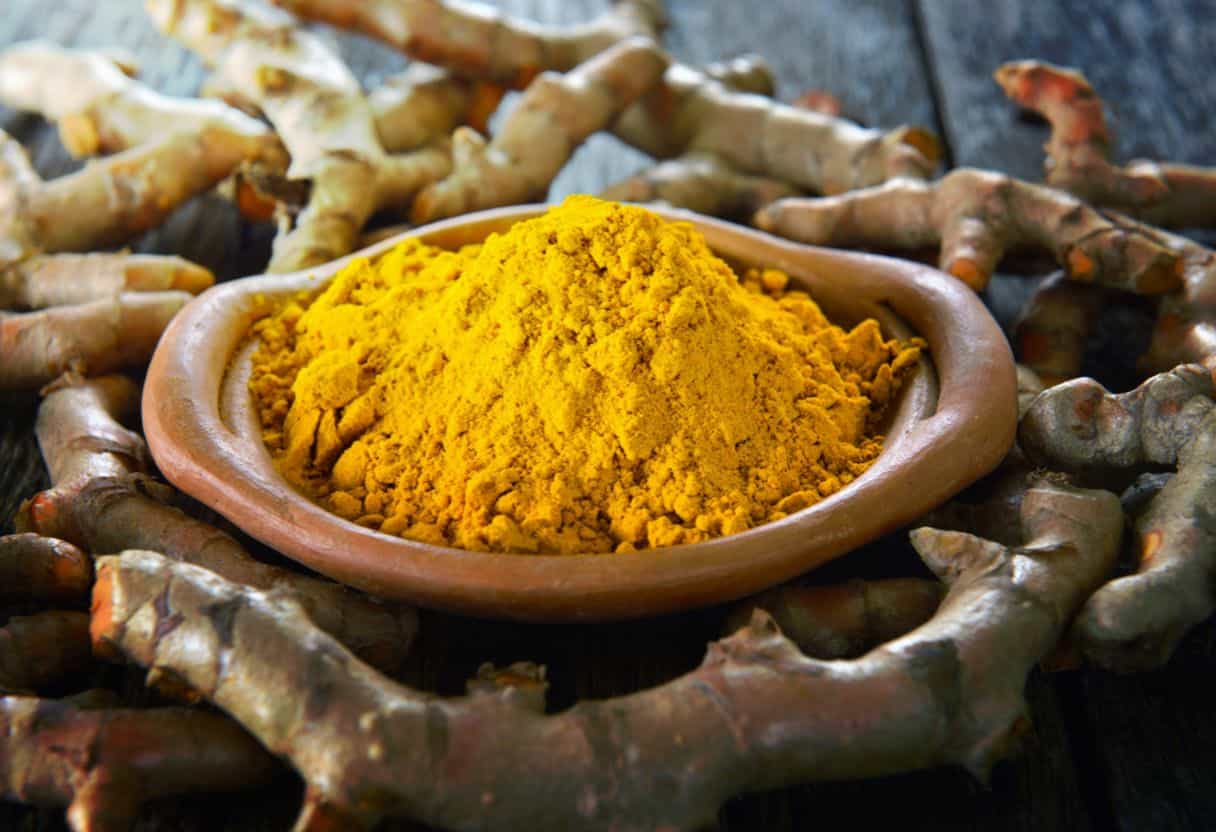
Turmeric, a vibrant yellow spice, not only provides an eye-catching color to dishes but also imparts a distinctive earthy taste. As you explore its culinary versatility, you’ll find that this spice is not just for curries — it can invigorate your side dishes, salads, and marinades with both its flavor and health-promoting qualities.
Spicing Up Side Dishes and Salads
Turmeric’s bold hue can transform the visual appeal of side dishes and salads. Incorporating turmeric into rice dishes not only adds a golden color but also subtle, warm undertones of flavor. Moreover, by mixing turmeric into salad dressings, you elevate both the nutrition and taste profile of your greens. For example, adding a teaspoon of turmeric to your dressing can make even a simple salad stand out. Here’s a quick breakdown:
| Recipe | Turmeric Usage | Enhancement |
|---|---|---|
| Quinoa Salad | Blend with lemon and olive oil dressing | Adds depth and warmth |
| Sautéed Vegetables | Toss with a pinch of turmeric | Introduces a nuanced flavor |
Turmeric as a Marinade and Seasoning
Not only does turmeric serve as a vibrant seasoning, but it also functions as a powerful marinate component. When you marinate chicken or fish with turmeric, the spice doesn’t overpower; rather, it complements the other seasonings, creating a harmonious blend. Additionally, turmeric in baking brings an unexpected twist to breads, turning them into conversation pieces both for their distinctive taste and impressive color palette. For instance, a turmeric and herb bread can be the highlight of your dining table.
Interestingly, while many people focus on turmeric’s use in traditional dishes, recent studies have uncovered that incorporating it into your diet can increase the antioxidant capacity of the body, hinting at broad health benefits (Food Revolution Network). The key is to start small and build up to find the right balance for your palate. Here are some specific ideas:
| Marinade/Seasoning | Recommendations |
|---|---|
| Chicken Marinade | Mix with garlic, yogurt, and lemon juice |
| Seasoned Bread | Combine with rosemary and garlic |
Experimenting with turmeric allows you to enhance not just the flavor profile but also the nutritional value of your meals.
Turmeric in Sweet Treats and Desserts
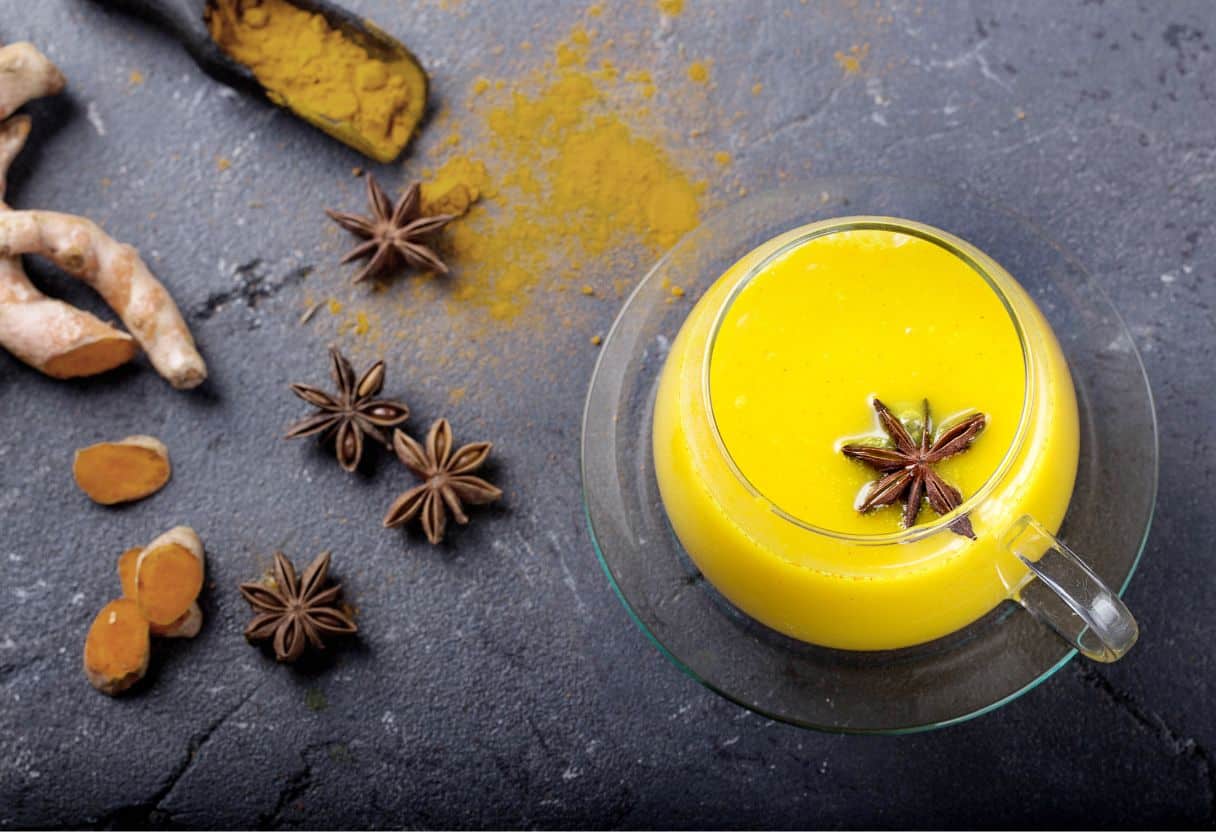
Imagine elevating your dessert recipes with a spice that not only adds a vibrant golden hue but also has health benefits that have been revered for centuries. Turmeric, known for its bold flavor and anti-inflammatory properties, can transition seamlessly into your dessert repertoire, offering an unsuspected twist that is as delightful to the palate as it is pleasing to the eye.
Turmeric in Baked Goods and Cakes
Baking with Turmeric:
- Cakes: Incorporating turmeric into your cake recipes can give them a warm, earthy note and a beautiful color. For a subtle touch, a teaspoon of turmeric can be added to the batter. If you’re looking to make the turmeric a star feature, increase the amount to suit your taste.
- Cookies: Add a pinch of turmeric to cookie dough, such as in ginger or shortbread cookies, for an antioxidant boost.
Recipe Recommendation:
- Golden milk cake: Inspired by the classic drink, a golden milk turmeric cake infuses traditional spices like cinnamon and cardamom with turmeric to create a moist, flavorful dessert that’s both comforting and exotic.
Desserts with a Hint of Turmeric
Creative Turmeric Infusions:
- Honey: Drizzle turmeric-infused honey over your favorite desserts, like panna cotta or Greek yogurt, for an intriguing addition of flavor and health.
- Cheese: Enhance your cheesecake or cream cheeses spread with a sprinkle of turmeric for a surprisingly delightful twist.
Summary of Key Dessert Ideas:
| Dessert | Turmeric Twist | Notes |
|---|---|---|
| Ice Cream | Golden milk variety | Turmeric pairs well with creamy textures for a subtle spice. |
| Raw Cupcakes | Mango and turmeric fusion | The sweetness of mango balances the spiciness of turmeric. |
Highlighted Statistic:
Interesting to note is that while the use of turmeric in desserts is less common, its integration into sweet dishes is growing. In fact, dishes like turmeric-flavored mac and cheese are merging the lines between savory and sweet, showing a 7% increase in menu appearances over the last year (Simply Quinoa).
By inviting turmeric into your desserts, you open up a world of culinary creativity and health-forward indulgence. Whether it’s in baked goods or innovative dessert concepts, turmeric can make your sweet treats stand out with its unique appeal.
Storing and Preserving Turmeric
Imagine you’ve just returned from the market with a vibrant bundle of fresh turmeric. Your next step is to ensure it retains its potent flavor and health benefits for as long as possible. Proper storage and preservation techniques can extend the life of your turmeric significantly.
Best Practices for Storage
In the Fridge: For short-term storage, place fresh turmeric in a produce bag with a paper towel to absorb excess moisture. This method prevents mold and keeps turmeric fresh for a few weeks.
In the Pantry: Dried, powdered turmeric should be stored in an airtight jar away from direct sunlight to protect its curcumin content—the compound responsible for most of turmeric’s health benefits.
Making Turmeric Pastes and Pickles
Turmeric Pastes: Combine fresh, grated turmeric with a bit of oil and black pepper to create a turmeric paste. This mixture can then be refrigerated and easily added to dishes to enhance flavor and nutrient intake.
Turmeric Pickles: As an interesting method of preservation, turmeric can be made into pickles. The pickling process infuses turmeric with additional flavors while extending its shelf life.
| Form | Storage Method | Shelf Life |
|---|---|---|
| Fresh Root | Fridge (produce bag) | Up to a few weeks |
| Powder | Airtight jar in pantry | Several months |
| Paste | Fridge in airtight container | 1-2 weeks |
| Pickles | Fridge in sealed jar | Several months |
Attention: About 5-6% of the curcumin content may be lost after 6 months of storage, yet it’s a minimal reduction in the grand scheme, underscoring the spice’s shelf stability.
By using these methods, you can ensure your turmeric remains a flavorful and beneficial component of your cooking for as long as possible.
Cooking Tips and Techniques
In your culinary adventures, imagine harnessing the golden power of turmeric, a spice revered for its vibrant color and compelling health benefits. However, while turmeric adds an exotic twist to your dishes, it also demands a nuanced approach to balance its earthy characteristics and avoid stains that its bright pigment can leave behind.
Pairing Turmeric with Complementary Spices
You’ll find that turmeric pairs wonderfully with a host of spices, though it shines brightest alongside certain partners. Incorporate black pepper to not only enhance the flavor but also increase the absorption of turmeric’s active ingredient, curcumin. A classic combination within many curry powders, turmeric blends well with cumin, coriander, and cardamom, creating a harmonious mix that’s perfect for savory dishes.
Here’s a basic spice mix with turmeric that you can try:
- 2 tsp ground turmeric
- 1 tsp ground cumin
- 1 tsp ground coriander
- 1/2 tsp black pepper
- 1/2 tsp ground cardamom
Remember, you don’t always need to stick to exact measurements—feel free to adjust these ratios to cater to your palate or to use this blend as a substitute for store-bought curry powders.
Managing Turmeric Stains and Clean-up
Turmeric is infamous for its persistence in leaving behind a bright yellow stain. To manage the aftermath of cooking with this spice, act promptly. If turmeric stains your utensils or countertops, use a paste of baking soda and water, and let it sit before scrubbing. For clothing stains, treating the spot with a mix of vinegar and water before a regular wash can be surprisingly effective. Always protect your surfaces and wear aprons to minimize direct contact with turmeric.
When it comes to turmeric, a little goes a long way. Its bitter taste can overwhelm the flavor profile of your dish if used in excess. Start with a small amount, especially if you’re using ground turmeric, and adjust to preference. See this guide on how to use turmeric for more detailed insights on quantities and proportions in recipes.
Turmeric in Special Diets
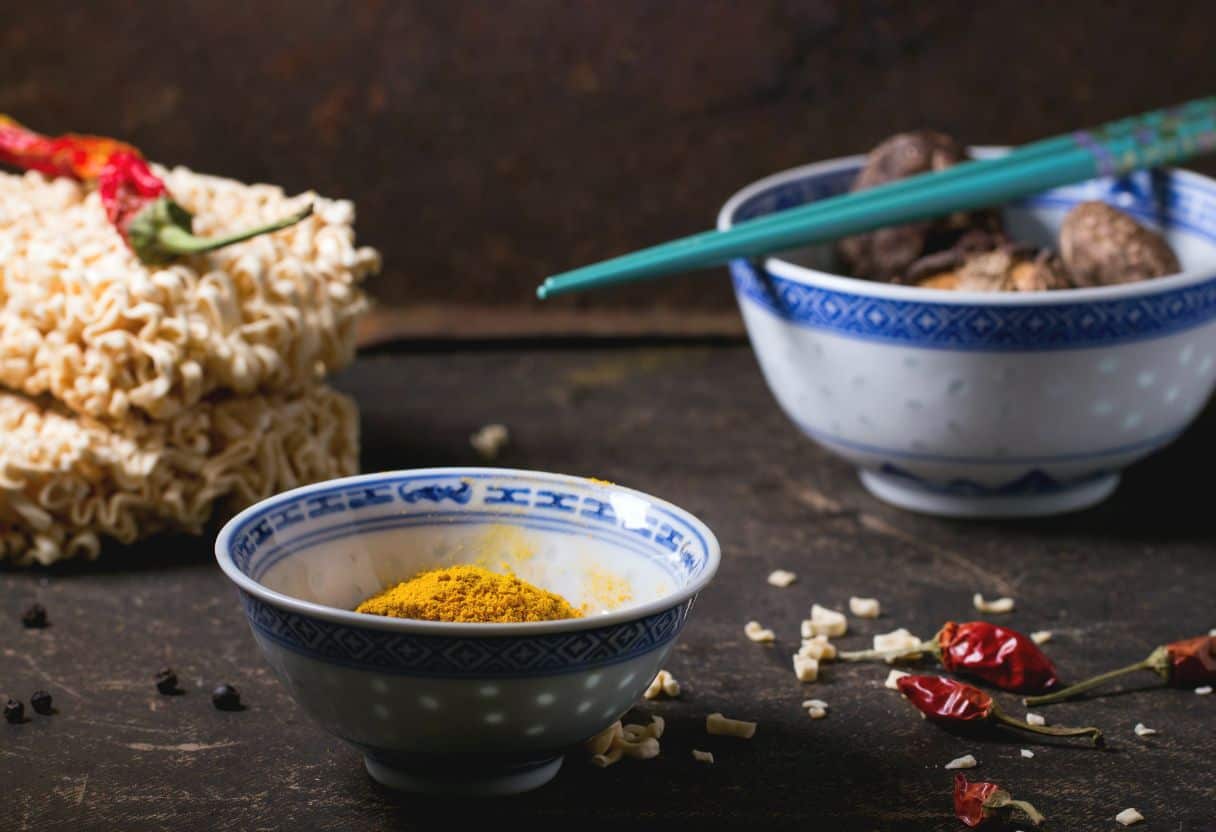
Picture yourself in a bustling spice market, the aroma of earthy, pungent spices hanging heavy in the air. Among them, turmeric shines like golden treasure, promising not just vibrant color and a peppery flavor, but also a host of health benefits, particularly for those on special diets. With its anti-inflammatory properties, turmeric could be a staple in your kitchen, turning the simplest ingredients into a healing meal.
Turmeric in Gluten-Free and Dairy-Free Recipes
Incorporating turmeric into gluten-free and dairy-free recipes can be thankfully straightforward. Turmeric happily complements a variety of plant-based milks, such as coconut milk, which not only creates rich, creamy dishes but also contributes to the absorption of its active compound, curcumin. Here are some thoughtfully selected ways to use turmeric:
- Golden Milk: A soothing blend of turmeric with coconut milk, sweetened with a touch of honey or maple syrup, and a pinch of black pepper to enhance absorption.
- Turmeric Tahini Dressing: Whisk turmeric with tahini, lemon juice, and garlic for a vibrant dressing that’s perfect for drizzling over fresh salads or roasted vegetables.
- Quinoa Turmeric Pilaf: Stir turmeric into your quinoa cooking water for a flavorful and visually striking base to your meals.
Remember, turmeric is versatile enough to add a gentle warmth to sweet and savory dishes without the need for gluten or dairy.
Turmeric for Anti-Inflammatory Diets
When approaching an anti-inflammatory diet, turmeric is often a top-choice spice due to its curcumin content, known to reduce inflammation. Interestingly, less discussed is that only about 3% of turmeric is comprised of this potent compound. Boost the impact of turmeric in your diet with these recommendations:
- Turmeric-infused Hummus: Blend turmeric into homemade hummus for an anti-inflammatory twist on a classic dip.
- Anti-Inflammatory Smoothies: Add a teaspoon of turmeric to your smoothies with a mix of anti-inflammatory fruits like berries or cherries.
| Ingredient | Recipe Suggestion | Potential Benefits |
|---|---|---|
| Turmeric | Turmeric-infused Hummus | May reduce joint inflammation |
| Coconut Milk | Golden Milk | Lends creaminess; supports curcumin absorption |
By thoughtfully adding turmeric into your anti-inflammatory diet, you may find not only a delightful new flavor profile but also a natural way to support your health.
Turmeric in Condiments and Dressings
Imagine enhancing your favorite salads and sandwiches with the golden touch of turmeric, a spice known not only for its vibrant color and earthy flavor but also for its potential health benefits. Turmeric’s active component, curcumin, has anti-inflammatory properties, which can add a healthful twist to your condiments and dressings.
Turmeric-Infused Oils and Dressings
Creating Turmeric-Infused Oils:
- Start with a high-quality, neutral oil like grapeseed or avocado oil.
- Gently warm the oil and add a teaspoon of ground turmeric per cup of oil.
- Allow the mixture to simmer for 2-3 minutes, then cool and strain for a clear, infused oil.
Recipes for Turmeric Salad Dressings often incorporate an assortment of ingredients to complement turmeric’s distinct flavor. Here’s a simple dressing to liven up your salads:
- 3 tablespoons turmeric-infused oil
- 1 tablespoon lemon juice
- 1 tablespoon honey
- Salt and pepper to taste
Whisk the ingredients together and drizzle over a fresh dill and mixed greens salad. This combination can elevate the flavors and add a punch of color.
Enhancing Dips and Spreads with Turmeric
Turmeric Tahini Dip:
Combining tahini with turmeric creates a rich, creamy dip that’s perfect for vegetable sticks or pita bread. Mix together:
- ½ cup tahini
- 1 tablespoon turmeric-infused oil
- 1 minced garlic clove
- Lemon juice to taste
Did you know? A pinch of turmeric can revitalize store-bought hummus. Add ¼ teaspoon of turmeric to a cup of hummus for a colorful and flavorful boost.
By incorporating turmeric into your condiments and dressings, you’re not only enjoying delicious flavors but also tapping into the potential health benefits of this celebrated spice. Recent studies indicate that curcumin supplementation can lead to significant reductions in markers of inflammation, making turmeric a valuable addition to your pantry (Link to a Relevant Study on Turmeric and Inflammation). Embrace the zest of turmeric and give your meals a healthful, flavorful lift.
Adapting Turmeric for Contemporary Cooking
Imagine you’re exploring a modern kitchen, where traditional spices blend with new techniques. Turmeric isn’t just for curries anymore; its vibrant color and unique taste have found a new playground. Now, let’s step into a world where turmeric meets cutting-edge cooking methods.
Sous-Vide Cooking with Turmeric
When sous-vide enters the scene, flavors infuse more intimately with your food. Adding turmeric to your sous-vide bag along with fish or chicken not only imparts its signature earthy notes but also tinges your proteins with a golden hue. For precision, consider a turmeric-infused olive oil: drizzle a couple of tablespoons into the bag. As the heat circulates, turmeric’s compounds, such as curcumin, which have been noted for their anti-inflammatory properties, disperse evenly, ensuring each bite is both flavorful and nutritious.
- Tip: Seal a pinch of turmeric with vegetables and a dash of pepper to enhance nutrient absorption.
Molecular Gastronomy and Turmeric
Transitioning to the avant-garde, molecular gastronomy elevates turmeric to a spectacle of taste and texture. Imagine spherification turning turmeric-infused coconut milk into caviar-like pearls that burst with flavor, or a fine powder that dissolves on the tongue, marrying the spice with modern cuisine’s playfulness. Here’s how you can integrate turmeric into this innovative cooking realm:
Recipe Idea: Turmeric pearls, created by mixing turmeric juice with sodium alginate and then dropping it into a calcium chloride bath.
| Ingredient | Directions |
|---|---|
| Turmeric Juice | Turmeric-infused Hummus |
| Calcium Chloride | Golden Milk |
| Water | Use for rinsing perls |
When used in these contemporary applications, turmeric’s role transcends flavoring — it becomes an interactive element on your plate.
For those delving into modern cuisine, you’ve learned that your spice cabinet holds more potential than meets the eye. Turmeric, when guided by your innovation, can be the centerpiece in a culinary art piece that dances between art and science.

